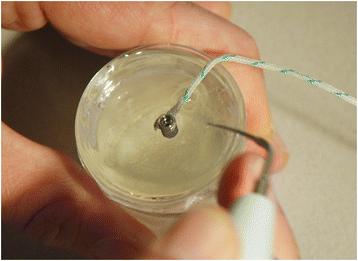Implant, Abutment, Complication, Fracture
Figure 1. Implant embedded in epoxy resin with thermocouple at the outer surface. : Temperature rise during removal of fractured components out of the implant
author: Eric W Meisberger, Sjoerd J G Bakker, Marco S Cune | publisher: drg. Andreas Tjandra, Sp. Perio, FISID

Figure 1. Implant embedded in epoxy resin with thermocouple at the outer surface.
Serial posts:
- Abstract : Temperature rise during removal of fractured components out of the implant body: an in vitro study comparing two ultrasonic devices and five implant types
- Background : Temperature rise during removal of fractured components out of the implant body: an in vitro study comparing two ultrasonic devices and five implant types [1]
- Background : Temperature rise during removal of fractured components out of the implant body: an in vitro study comparing two ultrasonic devices and five implant types [2]
- Methods : Temperature rise during removal of fractured components out of the implant body: an in vitro study comparing two ultrasonic devices and five implant types
- Results : Temperature rise during removal of fractured components out of the implant body: an in vitro study comparing two ultrasonic devices and five implant types [1]
- Results : Temperature rise during removal of fractured components out of the implant body: an in vitro study comparing two ultrasonic devices and five implant types [2]
- Discussion : Temperature rise during removal of fractured components out of the implant body: an in vitro study comparing two ultrasonic devices and five implant types [1]
- Discussion : Temperature rise during removal of fractured components out of the implant body: an in vitro study comparing two ultrasonic devices and five implant types [2]
- Discussion : Temperature rise during removal of fractured components out of the implant body: an in vitro study comparing two ultrasonic devices and five implant types [3]
- Conclusions : Temperature rise during removal of fractured components out of the implant body: an in vitro study comparing two ultrasonic devices and five implant types
- References : Temperature rise during removal of fractured components out of the implant body: an in vitro study comparing two ultrasonic devices and five implant types [1]
- References : Temperature rise during removal of fractured components out of the implant body: an in vitro study comparing two ultrasonic devices and five implant types [2]
- References : Temperature rise during removal of fractured components out of the implant body: an in vitro study comparing two ultrasonic devices and five implant types [3]
- References : Temperature rise during removal of fractured components out of the implant body: an in vitro study comparing two ultrasonic devices and five implant types [4]
- Acknowledgements : Temperature rise during removal of fractured components out of the implant body: an in vitro study comparing two ultrasonic devices and five implant types
- Author information : Temperature rise during removal of fractured components out of the implant body: an in vitro study comparing two ultrasonic devices and five implant types
- Additional information : Temperature rise during removal of fractured components out of the implant body: an in vitro study comparing two ultrasonic devices and five implant types
- Rights and permissions : Temperature rise during removal of fractured components out of the implant body: an in vitro study comparing two ultrasonic devices and five implant types
- About this article : Temperature rise during removal of fractured components out of the implant body: an in vitro study comparing two ultrasonic devices and five implant types
- Figure 1. Implant embedded in epoxy resin with thermocouple at the outer surface. : Temperature rise during removal of fractured components out of the implant
- Figure 2. Results for all implants instrumented with two tested ultrasonic devices, either with or without cooling. (a) Temperature rise when instrumenting with the Satelec ultrasonic device without cooling. The horizontal dotted line denotes the assumed critical rise in temperature. Temperature rise at 30 s: bone level 3.3 mm > bone level 4.1 mm > Straumann regular neck 3.3 mm = Astra 3.5 mm = Straumann regular neck 4.8 mm. (b) Temperature rise when instrumenting with the Satelec ultrasonic device with cooling. The horizontal dotted line denotes the assumed critical rise in temperature. Temperature rise at 30 s: bone level 3.3 mm = Astra 3.5 implant > Straumann regular neck 3.3 mm = Straumann regular neck 4.8 mm. Temperature rise at the bone level 4.1 implant lies in between the bone level 3.3 mm and Astra 3.5 mm implant and both Straumann implants, but not significantly different from either of these implants. (c) EMS without cooling. Temperature rise at 30 s: bone level 3.3 mm = bon